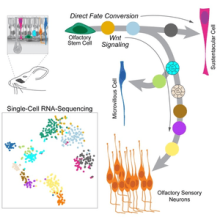Olfactory stem cells, neural regeneration, and injury-induced repair

In the vertebrate olfactory system, primary sensory neurons are continuously regenerated throughout adult life via the proliferation and differentiation of multipotent neural progenitor cells. This feature makes the olfactory system particularly amenable for studies of adult neurogenesis and the properties of neuronal stem cells. Olfactory sensory neurons normally turn over every 30-60 days and are replaced through the proliferation and differentiation of multipotent progenitor cells. Following injury that results in the destruction of mature cells in the olfactory epithelium, these adult tissue stem cells proliferate and differentiate to reconstitute all cells of this sensory epithelium.
The regenerative capacity of the olfactory epithelium represents a powerful and experimentally accessible paradigm for understanding the regulation of neural stem cell function under normal conditions and during injury-induced regeneration. While distinct stages of the olfactory neuron developmental lineage have been identified, much remains to be learned about the genetic programs that both define and regulate olfactory neurogenesis during development and regeneration.
Current projects are using a variety of approaches – including targeted gene knockouts to assess the function of transcription factors and stem cell signaling pathways, and single cell/single nucleus sequencing – to elucidate the molecular and cellular mechanisms regulating olfactory stem cells and olfactory neurogenesis in the mouse. Our studies provide a model for understanding the mechanisms regulating adult neural stem cells and lay the groundwork for the future development of treatments and therapeutics to ameliorate tissue damage and degeneration in the nervous system.
